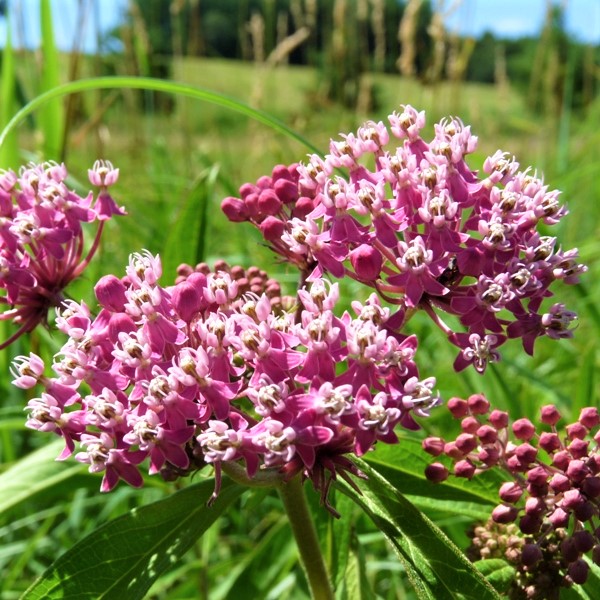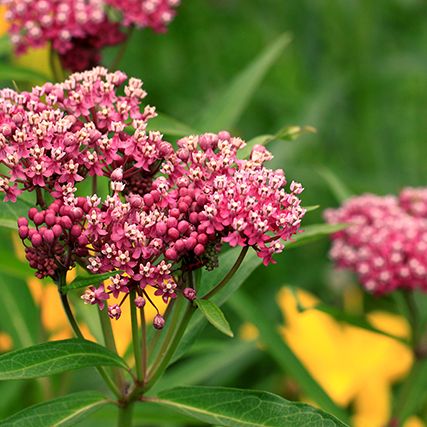

Swamp Milkweed
Asclepias incarnata
88 reviews
Swamp Milkweed
Asclepias incarnata
88 reviews
- Beautiful pink blooms attract butterflies and bees
- Tolerant of wet soil conditions, perfect for rain gardens or low-lying areas
- Low maintenance perennial, perfect for beginner gardeners
- Recommended by landscape designers for optimal fit in real yards
$74.00
$106.00
30% Off
- Ships to in 3-5 Days
- Free Shipping Over $150
- Plant Arrival Guarantee
- In Stock
- Free Plant Consult
$200 - Landscape-Approved: Every Plant We Sell Comes With Design Expertise Behind It
1.5 Gallon
We are sorry, product is currently out of stock due to seasonal availability. Please check the "Related plants available in your area" section below
Not just beautiful - intentionally selected by ShrubHub's 3D landscape design team to fit real-world spaces and maximize yard potential.
Why Swamp Milkweed?
Swamp milkweed is a herbaceous perennial plant that can grow up to 5 feet tall. It is native to wetlands and can thrive in moist soil conditions, making it a great addition to rain gardens or near bodies of water. Swamp milkweed produces clusters of pink or purplish flowers that attract bees, butterflies, and other pollinators. Its leaves and stems provide food for the caterpillars of monarch butterflies, making it an ideal plant for butterfly gardens and conservation efforts.
Sunlight
Swamp Milkweed requires full sun or partial shade to thrive.
Watering
Swamp Milkweed requires consistently moist soil. It prefers wet or moist habitats, such as wetlands and swampy areas. Regular watering is necessary, especially during periods of drought, to ensure the plant receives enough water to thrive.
Fertilizing
Swamp Milkweed (Asclepias incarnata) requires a well-drained soil rich in organic matter and benefits from the addition of a balanced fertilizer, such as a 10-10-10. Avoid overfertilizing the plant, as excessive nutrients can lead to weak growth and fewer
Swamp Milkweed – A Monarch's Haven!
Welcome the vibrant charm of Swamp Milkweed into your garden – a native wildflower that graces your landscape with bold pink flowers for months on end.
This isn't just a flower; it's a haven for Monarch butterflies and an exceptional nectar resource that brings life and movement to your garden.
Imagine your landscape transformed into a sea of brilliant pink blooms, painting the scene with unparalleled beauty.
Swamp Milkweed is a showstopper that commands attention, inviting pollinators and beneficial insects to join in its symphony of life.
This rugged native wildflower is a symbol of resilience, growing effortlessly in wet soil.
Its value is unmatched, especially in areas where water is abundant.
Very cold hardy, Swamp Milkweed stands strong against harsh winters, emerging each spring to paint your garden with life.
Deer rarely cause damage to this plant, ensuring its beauty remains intact.
With a mature height of 4 to 5 feet and a spread of 2 to 3 feet, Swamp Milkweed stands proudly as a vertical marvel that adds a touch of elegance to your garden's composition.
Whether you're a seasoned gardener or a newcomer to the green scene, Swamp Milkweed is an easy-care perennial that's a valuable addition to any landscape.
Embrace its beauty, its role in supporting beneficial insects, and its contribution to the cycle of life in your garden.
Ready to become a steward of nature and welcome Monarchs to your garden?
The time is now to make Swamp Milkweed a part of your landscape.
Order this plant today from our ShrubHub store and watch your garden transform into a haven of life and beauty.
Invite Monarchs and life into your garden with Swamp Milkweed – Order Now from our ShrubHub Store!
Plant Information:
| Botanical Name: | Asclepias incarnata |
| USDA Zones: | 3 - 6 |
| Water: | Moderate to High (not standing water) |
| Exposure: | Full Sun |
| Soil Needs: | Tolerates All Well-Drained |
| Mature Height: | 4 - 5 Feet |
| Mature Spread: | 2 - 3 Feet |





Pollination Info
Pollination of Swamp Milkweed (Asclepias incarnata)
Swamp milkweed is a native perennial plant native to North America, which is known for attracting butterflies and other pollinators. It can grow up to 3-4 feet tall and blooms from June to August.
Swamp milkweed is also known for its unique pollination mechanism. The flowers produce nectar and pollen, which attract a variety of insects and animals, especially butterflies and bees.
The flowers have a complex structure that serves to prevent self-pollination and increase the likelihood of cross-pollination. The flowers have five petals that curve both inwards and downwards, forming a shape that insects find difficult to navigate. As a result, they must climb around and through the petals to access the nectar and pollen.
Inside the flowers, there are five hoods that collect and store pollen. The hood is attached to a small stalk known as a pollinium, which acts as a lever. When an insect lands and begins to search for nectar, its leg may accidentally brush against the pollinium. Once the insect leaves the flower, the pollinium is pulled off and moves with the insect. When the insect visits another milkweed flower, the pollinium may become attached to the stigma, resulting in successful cross-pollination.
Overall, the pollination of swamp milkweed is crucial for the survival and reproduction of various insect and animal species. It also contributes to the health and diversity of local ecosystems.
FAQ
Swamp Milkweed (Asclepias incarnata) FAQ
Q: What is swamp milkweed?
A: Swamp milkweed (Asclepias incarnata) is a perennial plant native to North America. It grows best in full sun and moist to wet soil conditions.
Q: What does swamp milkweed look like?
A: Swamp milkweed has tall stems, reaching up to 4 feet in height. Its flowers are pink to lavender in color and bloom from mid-summer to early fall. The plant also has long, narrow leaves that grow up to 8 inches in length.
Q: How do I grow swamp milkweed?
A: Swamp milkweed can be grown from seed or propagated through division of established plants. It prefers moist to wet soil and full sun, but can also tolerate some shade. It is important to make sure the plant does not dry out during periods of drought.
Q: Is swamp milkweed a good plant for pollinators?
A: Yes, swamp milkweed is a particularly important plant for monarch butterflies. The larvae of the monarch butterfly feed exclusively on milkweed plants, including swamp milkweed. The flowers of swamp milkweed also attract a variety of other pollinators, such as bees and butterflies.
Q: Is swamp milkweed toxic?
A: Yes, all parts of the swamp milkweed plant are toxic if ingested. However, the toxicity level is relatively low and is not typically harmful to humans or pets if small amounts are ingested.
Q: What are some common uses for swamp milkweed?
A: Swamp milkweed is commonly used in native plant gardens, wetland restoration projects, and butterfly gardens. Its flowers also make a beautiful addition to cut flower arrangements.
Planting & Care
Planting Swamp Milkweed (Asclepias incarnata)
Swamp milkweed is a native perennial plant that requires full to partial sun and moist soil. It can be planted from seed or root cuttings.
Planting from Seed:
- Plant seeds in the fall for natural winter stratification or stratify indoors by placing seeds in a plastic bag with damp sand in the refrigerator for at least three weeks before planting.
- Sow seeds 1/8 inch deep and space them 2-3 inches apart.
- Keep soil moist and seedlings will germinate in 2-3 weeks.
Planting from Root Cuttings:
- Cut roots into 2-3 inch sections in the fall or early spring.
- Plant the cuttings 1-2 inches deep and space them 12-18 inches apart.
- Keep soil moist and rooted cuttings will begin to sprout in a few weeks.
Caring for Swamp Milkweed:
Swamp milkweed requires little care once established but can be susceptible to foliar diseases in humid conditions. Here are some tips to help your plant thrive:
Watering:
Water regularly during the first growing season to help establish roots. After that, swamp milkweed is drought tolerant, but will benefit from occasional watering during long dry spells.
Fertilizing:
Swamp milkweed does not need fertilization, but if you choose to fertilize, use a balanced fertilizer in the spring. Too much nitrogen can cause excessive leaf growth and few flowers.
Pest and Disease Control:
Aphids and milkweed bugs can be a problem but can usually be controlled with insecticidal soap or by introducing beneficial insects like ladybugs.
Foliar diseases like powdery mildew and leaf spot can be a problem in humid conditions. Trim off diseased leaves and dispose of them in the trash. Do not compost diseased plant material as it can spread diseases.
Pruning:
Prune dead stems and leaves in the fall after the plant has gone dormant.
Propagation:
Swamp milkweed can be divided every few years in the spring or fall. Simply divide the root ball into sections and replant.
Check Out These Verified Customer Reviews:
Customer Reviews
4.7 out of 5 based on 88 reviews
Thank you! Your review has been submitted.
Great quality swamp milkweed, exactly as described.
The swamp milkweed exceeded my expectations, very happy.
Item arrived in excellent condition.
Item has been added to your cart.


